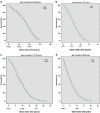Ocular pseudoexfoliation syndrome and life span
- PMID: 26288849
- PMCID: PMC4534680
- DOI: 10.1016/j.ebiom.2015.05.024
Ocular pseudoexfoliation syndrome and life span
Abstract
Background: To compare life span of persons with and without ocular pseudoexfoliation syndrome (PES).
Methods: The study is based on an epidemiological survey conducted in Sør-Trøndelag county, Norway, in 1985-86. All inhabitants over 64 years of age (2109 individuals) were invited. Mortality information was obtained from The Norwegian Institute of Public Health in 2014, by which time 99% of the participants were deceased.
Results: When adjusting for age and gender, life span was not statistically different in persons with and without PES. Following the diagnosis of PES, patients' survival was up to, and beyond, 30 years.
Conclusions: Our observations suggest that, despite all the systemic aberrations reported in persons with ocular PES, none or only marginal functional changes are caused in extraocular organs and tissues. The present study supports the notion that systemic PES is not a life-threatening condition.
Keywords: Cardiovascular disease; Eye; Life span; Mortality; Ophthalmology; Pseudoexfoliation syndrome; Survey.
Figures




Comment in
-
Ocular Pseudoexfoliation Syndrome and Life Span: Act 2.EBioMedicine. 2015 Jun 10;2(7):640-1. doi: 10.1016/j.ebiom.2015.06.006. eCollection 2015 Jul. EBioMedicine. 2015. PMID: 26288835 Free PMC article. No abstract available.
References
-
- Akarsu C., Ünal B. Cerebral haemodynamics in patients with pseudoexfoliation glaucoma. Eye. 2005;19:1297–1300. - PubMed
-
- Atalar P.T., Atalar E., Kilic H., Abbasoglu Ö.E., Ozer N., Aksöyek S., Övünc K., Ozmen F., Gürsel E. Impaired systemic endothelial function in patients with pseudoexfoliation syndrome. Int. Heart J. 2006;47:77–84. - PubMed
-
- Bettis B.I., Allingham R.R., Wirostko B.M. Systemic diseases associated with exfoliation syndrome. Int. Ophthalmol. Clin. 2014;54(4):15–28. - PubMed
-
- Boushey C.J., Beresford S.A., Omenn G.S., Motulsky A.G. A quantitative assessment of plasma homocysteine as a risk factor for vascular disease. Probable benefits of increasing folic acid intakes. JAMA. 1995;274:1049–1057. - PubMed
MeSH terms
LinkOut - more resources
Full Text Sources
Other Literature Sources

